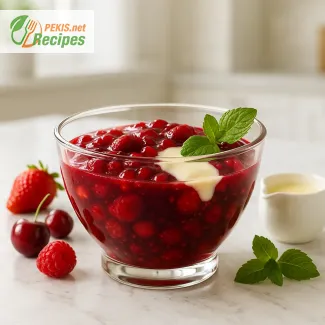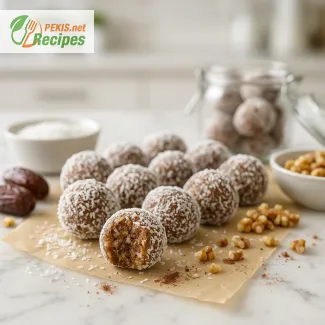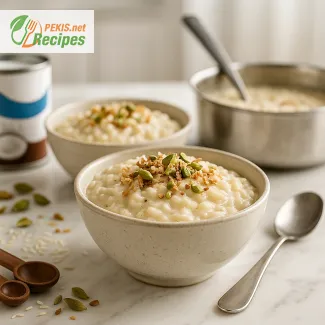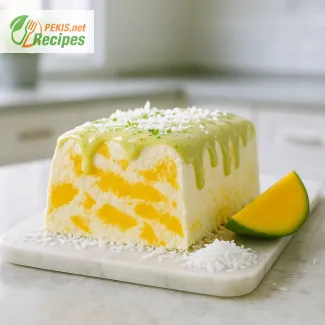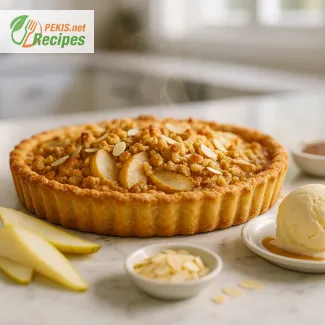Creamy and versatile Homemade Coconut Cream delivers rich flavor and silky texture in just 15 minutes (prep 10 min, cook 5 min) for 4 servings. Made from full-fat coconut milk, it’s naturally dairy-free, vegan, and perfect for both sweet and savory dishes — from curries to desserts. The cream thickens as it cools, creating a smooth, spoonable consistency that stores well for up to 5 days in the refrigerator. Ideal for whipping, baking, or enriching sauces, this recipe brings tropical aroma and indulgent texture to any dish.
Experimenting with natural plant-based ingredients has always been about finding balance between flavor, texture, and simplicity. Coconut cream quickly became a favorite — not just for its rich body, but for how it transforms basic ingredients into something luxurious without effort. There’s something special about watching a simple can of coconut milk turn into a smooth, glossy cream that works just as beautifully in desserts as in savory curries.
PEKIS – professional chef and recipe developer with over 25 years of experience in cooking and baking, specializing in European and international cuisine.
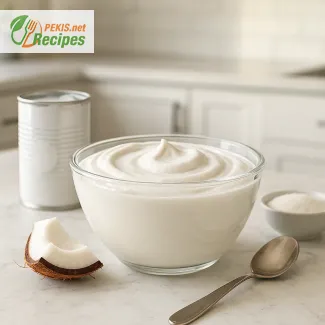
Silky Homemade Coconut Cream for Desserts, Drinks, and Curries
A luxurious dairy-free base that adds smooth texture and tropical aroma to every dish
Few ingredients in the kitchen feel as comforting and versatile as coconut cream — that lush, silky layer that forms from full-fat coconut milk when it’s left to rest. Its rich texture, gentle sweetness, and unmistakable tropical aroma make it an essential companion for both sweet and savory creations. From velvety desserts and creamy soups to curries and smoothies, coconut cream brings a natural depth and indulgence that’s impossible to replicate with dairy alternatives.
Originating from the tropical regions of Southeast Asia and the Pacific Islands, coconut cream has long been a foundation of local cuisines. Traditionally prepared by pressing the grated flesh of mature coconuts, it became prized for its ability to thicken sauces, enrich pastries, and balance spicy dishes with its soothing creaminess. In countries like Thailand, Sri Lanka, and the Philippines, it’s a core ingredient that transforms simple meals into fragrant, comforting dishes. Over time, it found its way into Western kitchens, celebrated for being vegan, lactose-free, and full of natural fats that create a smooth, glossy texture in sauces and batters.
Texture, flavor, and versatility in one ingredient
Coconut cream offers a balance between thickness and delicacy that makes it ideal for endless applications. Its fat content gives body and smoothness to puddings, mousses, and even ice creams, while its subtle sweetness harmonizes with chocolate, vanilla, or fruit-based desserts. When used in savory cooking, it softens bold spices, giving depth to curry pastes, soups, and sauces without overpowering the dish.
Unlike coconut milk, which is thinner and lighter, coconut cream contains more fat, resulting in a richer consistency. When chilled, it separates into a thick layer on top — the perfect base for whipped coconut cream or for folding into cold desserts. Stirred into hot dishes, it blends seamlessly to create a silky mouthfeel that enhances both taste and aroma.
Why you’ll love this coconut cream
- Naturally dairy-free and perfect for vegan or lactose-free cooking.
- Rich and creamy texture that elevates both desserts and savory dishes.
- Mild tropical flavor that complements chocolate, fruit, and spices.
- Simple preparation with just one main ingredient and no additives.
- Perfect for meal prep – keeps its consistency and flavor when stored properly.
The sensory appeal of coconut cream
When gently heated, coconut cream releases an irresistible aroma reminiscent of tropical beaches and freshly cracked coconuts. Its natural oils contribute to a glossy sheen and smooth texture that feels indulgent but remains light. In baking, it replaces butter or cream to create moist, tender crumb structures, while in drinks, it lends an elegant silkiness to smoothies, milkshakes, or cocktails like piña coladas.
The taste is subtle yet complex — sweet, nutty, and faintly floral. It pairs beautifully with ingredients such as lime, ginger, mango, or dark chocolate, each drawing out a different nuance of flavor.
Creative variations and uses
There are countless ways to adapt coconut cream to your cooking style:
- Whipped coconut cream: Chill the cream, scoop the solid part, and whip it like dairy cream for a light topping.
- Coconut ganache: Combine with melted chocolate for a vegan-friendly glaze or truffle base.
- Infused cream: Simmer gently with lemongrass, vanilla, or cardamom for aromatic variations.
- Savory base: Use it in place of heavy cream for Thai curries, soups, or pasta sauces.
- Frozen desserts: Add it to homemade ice creams or fruit sorbets for a smoother texture.
Ingredient synergy and flavor balance
The beauty of coconut cream lies in how it interacts with other elements in a recipe. Acidic ingredients like citrus or berries cut through its richness, while spices such as cinnamon or nutmeg highlight its natural sweetness. In savory cooking, it complements ginger, chili, and garlic, adding depth without dulling their intensity. Its natural fat carries flavors beautifully, allowing them to blend smoothly across the palate.
In baking, mixing it with flour and sugar produces tender textures and long-lasting moisture. Combined with yeast or baking powder, it supports airy structures without losing richness. A small amount in frostings or custards gives a glossy, stable finish.
Storage and make-ahead preparation
Homemade coconut cream stores well when handled correctly. Place it in an airtight glass jar and keep it refrigerated for up to five days. Before using, stir or gently warm to restore its smooth consistency, as natural separation can occur. For longer storage, it can be frozen in small portions and thawed overnight in the fridge — ideal for meal prep or quick desserts. Avoid boiling after thawing, as it may cause the fats to separate.
A closer look at coconut cream’s cultural roots
In many tropical cultures, coconut cream is not just a cooking ingredient but a symbol of abundance and nourishment. In traditional Polynesian and South Asian dishes, it represents the harmony of nature’s flavors — rich, fresh, and balanced. Islanders have long used it to prepare celebratory dishes, from savory stews to sweet puddings, while in modern Western cuisine it has become a cornerstone of plant-based cooking, appreciated for its creaminess and depth.
Essential tips for perfect results
- Use high-quality, full-fat coconut milk if making cream from scratch.
- Avoid shaking or stirring before separating the cream from the liquid.
- Always chill before whipping for stable peaks.
- Do not overheat — gentle simmering preserves both texture and aroma.
- Store in clean, airtight containers to maintain freshness.
The essence of coconut cream in modern cooking
Today, coconut cream bridges traditional tropical recipes and modern dietary preferences. It satisfies a growing demand for natural, plant-based alternatives while keeping the comfort and luxury of classic creamy dishes. Whether enriching soups, finishing desserts, or balancing spicy sauces, it delivers texture, flavor, and aroma in one spoonful — a small ingredient with a big impact.
- Pour the full-fat coconut milk into a medium saucepan and place it over low to medium heat. Do not boil.
- Add a small amount of water to control the thickness — this ensures a smooth, creamy consistency.
- Stir gently and let it warm until the fat and liquid combine evenly, forming a silky, uniform texture.
- For a sweet variation, add sugar and vanilla extract, stirring continuously until dissolved.
- If you prefer a thicker cream (for desserts or fillings), dissolve cornstarch in 1 tablespoon of cold water and whisk into the warm mixture. Heat for 1–2 minutes until it thickens slightly.
- Remove from heat and let it cool. Once cooled, it will become thicker and ready for whipping or cooking.
- Store in an airtight glass container in the refrigerator for up to 5 days.
FAQ questionWhat is the difference between coconut cream and coconut milk?
Coconut cream is thicker, richer, and higher in fat than coconut milk. It’s made from the top, fatty layer of full-fat coconut milk and has a spoonable, velvety texture that holds shape, which makes it ideal for desserts, whipped toppings, and thick sauces. Coconut milk is more diluted, closer to a pourable liquid, and better suited for soups, lighter curries, and drinks. When a recipe calls for coconut cream, using coconut milk will result in a thinner, less creamy final dish.
FAQ questionHow do I make coconut cream thicker for desserts?
To achieve a pastry-level thickness, chill the coconut cream first so the fats separate and firm up. For an even thicker texture, gently heat it and whisk in a small amount of cornstarch 6 g (1 tbsp) dissolved in cold water. Cook briefly until it coats the back of a spoon. For whipping, only use the solidified part of the cream and keep the bowl cold — this gives a stable, airy texture perfect for topping cakes, puddings, or fruit.
FAQ questionCan homemade coconut cream be used in savory dishes?
Yes. Homemade coconut cream is naturally neutral-sweet with light coconut aroma, so it pairs well with curries, stews, creamy vegetable sauces, and mild seafood dishes. The fat content helps soften spices like chili, ginger, and garlic and gives the dish a silky mouthfeel. For savory use, skip the sugar and vanilla from the base recipe and add salt, lime juice, lemongrass, or curry paste instead to keep it balanced.
FAQ questionHow long does coconut cream keep and how should it be stored?
Properly stored in an airtight glass container in the refrigerator, coconut cream keeps for up to 5 days. It may separate into a thick layer and a lighter liquid — this is normal. Simply stir or warm gently to bring it back to a smooth consistency. Coconut cream can also be frozen in small portions (ice cube tray or 100 ml containers) and thawed in the fridge; use thawed cream for cooking, sauces, and baking rather than whipping.
FAQ questionCan coconut cream replace dairy cream 1:1?
In most recipes, yes — coconut cream can replace heavy cream in a 1:1 ratio for soups, sauces, curries, and many desserts. Keep in mind it has a coconut flavor, so it works best in recipes where a tropical or slightly sweet note is welcome. For completely neutral dishes, combine it with oat or cashew cream to mellow the taste. For baking, coconut cream also helps retain moisture and tenderness in cakes and quick breads.
FAQ questionWhy did my coconut cream split or look grainy?
Splitting usually happens when the cream is boiled too hard or heated too fast. Coconut fat separates from water at high heat. To prevent this, always cook on low to medium heat, whisk gently, and add thickeners only after the mixture is warm. If it has already split, you can often fix it by whisking in 1–2 tsp of warm water or by blending briefly to emulsify the fats again. Keeping the fat and water at the same temperature helps maintain a smooth, glossy texture.
Homemade coconut cream captures the essence of tropical simplicity — a single ingredient that transforms everyday dishes into something extraordinary. Its natural balance of richness and smooth texture brings depth to both sweet and savory creations, making it a kitchen essential for those who appreciate clean, plant-based indulgence.
When made fresh, the cream develops a subtle aroma that blends beautifully with spices, fruits, and herbs, allowing endless combinations in desserts, curries, and sauces. Its versatility and stability make it ideal for cooking, baking, or whipping, adapting effortlessly to whatever flavor direction you choose.
What makes it special is how naturally it supports modern cooking preferences — dairy-free, simple, and satisfying. By controlling the consistency, sweetness, and flavor notes, every batch becomes fully customizable to your taste or purpose. Whether used for a silky curry base or a light whipped topping, it adds an unmistakable creaminess and balance that elevate the entire dish.
Stored properly, coconut cream keeps its freshness and aroma for days, ready to enrich your next recipe without any additives. It’s proof that something so simple can deliver exceptional results — a smooth, flavorful foundation that connects traditional methods with modern cooking creativity.
Allergens present in the recipe:
- Coconut – present as the main ingredient.
Tips for allergen-free or gluten-free variations:
- For coconut allergy, replace with almond cream or soy-based cream.
- All ingredients are naturally gluten-free. Ensure cornstarch is certified gluten-free if sensitive.
- Iron – 2.1 mg – supports oxygen transport and energy production.
- Magnesium – 22 mg – promotes healthy muscle and nerve function.
- Potassium – 220 mg – helps regulate blood pressure and hydration.
- Calcium – 14 mg – contributes to bone and dental strength.
- Vitamin C – 1 mg – aids collagen formation and immune health.
- Vitamin E – 0.6 mg – protects cells from oxidative stress.
- Polyphenols – 15 mg – support heart health and reduce inflammation.
- Lauric acid – 12 g – offers antimicrobial and immune-boosting effects.
- Ferulic acid – 0.2 mg – helps neutralize free radicals and supports skin health.
